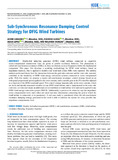Mostrar el registro sencillo del ítem
Sub-synchronous resonance damping control strategy for DFIG wind turbines
| dc.creator | Samanes Pascual, Javier | es_ES |
| dc.creator | Gubía Villabona, Eugenio | es_ES |
| dc.creator | López Taberna, Jesús | es_ES |
| dc.creator | Burgos, Rolando | es_ES |
| dc.date.accessioned | 2021-06-25T12:34:23Z | |
| dc.date.available | 2021-06-25T12:34:23Z | |
| dc.date.issued | 2020 | |
| dc.identifier.citation | J. Samanes, E. Gubia, J. Lopez and R. Burgos, 'Sub-Synchronous Resonance Damping Control Strategy for DFIG Wind Turbines', in IEEE Access, vol. 8, pp. 223359-223372, 2020, doi: 10.1109/ACCESS.2020.3043818. | en |
| dc.identifier.issn | 2169-3536 | |
| dc.identifier.uri | https://hdl.handle.net/2454/40054 | |
| dc.description.abstract | Doubly-fed induction generator (DFIG) wind turbines connected to capacitive series-compensated transmission lines are prone to exhibit oscillatory behavior. The phenomena is called sub-synchronous resonances (SSRs), as these oscillations occur at frequencies below the fundamental component. This paper first develops a modeling methodology for DFIG wind turbines, based on impedance matrices, that is applied to model a real wind farm where SSRs were reported. The stability analysis performed shows how the interaction between the grid-side converter and the rotor-side converter contribute to the instability of DFIG wind energy conversion systems connected to series compensated grids. With this model, we propose a simple sub-synchronous resonance control strategy based on an orthogonal proportional action applied to the rotor currents, and a variable gain in the PI controller adjusted as a function of the DFIG rotational speed. This control strategy depends only on the rotor currents, which are local and already measured variables in any DFIG wind turbine, and is implemented in the rotor side converter, so it does not imply an additional cost at wind farm or wind turbine level and can be applied to any DFIG wind energy conversion system (WECS). Additionally, it proves to be robust for any line impedance series compensation level, and it does not need real-time information concerning the grid at which the wind turbine is connected, or its parameters. A real case study is considered, where the sub-synchronous resonance damping strategy presented in this work is able to stabilize the system for every possible line impedance compensation level. | en |
| dc.description.sponsorship | This work was supported by the Agencia Estatal de Investigacion (AEI) (Spanish State Research Agency) under Grant PID2019-110956RB-I00/AEI/10.13039 and Grant DPI-2016-80641-R. | en |
| dc.format.extent | 14 p. | |
| dc.format.mimetype | application/pdf | en |
| dc.language.iso | eng | en |
| dc.publisher | IEEE | en |
| dc.relation.ispartof | IEEE Access, vol. 8, pp. 223359-223372, 2020 | en |
| dc.rights | This work is licensed under a Creative Commons Attribution 4.0 License. | en |
| dc.rights.uri | http://creativecommons.org/licenses/by/4.0/ | |
| dc.subject | Doubly-fed induction generator (DFIG) | en |
| dc.subject | Frequency response | en |
| dc.subject | Resonance damping | en |
| dc.subject | Sub-synchronous resonance (SSR) | en |
| dc.subject | Wind turbine | en |
| dc.title | Sub-synchronous resonance damping control strategy for DFIG wind turbines | en |
| dc.type | info:eu-repo/semantics/article | en |
| dc.type | Artículo / Artikulua | es |
| dc.contributor.department | Ingeniaritza Elektrikoa, Elektronikoaren eta Telekomunikazio Ingeniaritzaren | eu |
| dc.contributor.department | Institute of Smart Cities - ISC | en |
| dc.contributor.department | Ingeniería Eléctrica, Electrónica y de Comunicación | es_ES |
| dc.rights.accessRights | info:eu-repo/semantics/openAccess | en |
| dc.rights.accessRights | Acceso abierto / Sarbide irekia | es |
| dc.identifier.doi | 10.1109/ACCESS.2020.3043818 | |
| dc.relation.projectID | info:eu-repo/grantAgreement/AEI/Plan Estatal de Investigación Científica y Técnica y de Innovación 2017-2020/PID2019-110956RB-I00/ES/ | en |
| dc.relation.projectID | info:eu-repo/grantAgreement/ES/1PE/DPI2016-80641-R | en |
| dc.relation.publisherversion | https://doi.org/10.1109/ACCESS.2020.3043818 | |
| dc.type.version | info:eu-repo/semantics/publishedVersion | en |
| dc.type.version | Versión publicada / Argitaratu den bertsioa | es |



